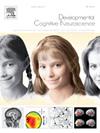胎儿功能连通性:使用图论检查产前母亲抑郁症状的作用
IF 4.9
2区 医学
Q1 NEUROSCIENCES
引用次数: 0
摘要
胎儿脑功能改变被认为是产前母亲抑郁(PMD)与后代神经发育结果之间关系的潜在机制。本研究运用图论探讨经前抑郁症状与胎儿脑功能连接(FC)的关系。共有123名孕妇参与了这项研究,完成了流行病学研究中心抑郁量表(CES-D),并接受了胎儿核磁共振扫描。结果显示,PMD症状升高与胎儿大脑右岛区整体效率降低之间存在显著关系。然而,由于胎儿年龄与岛脑区域的局部或整体效率无关,我们无法确定pmd相关的岛脑整体效率降低是否表明发育模式加速或延迟。这项研究是为数不多的研究胎儿大脑连接与产前母亲抑郁症相关的研究之一,为早期神经发育风险和早期干预的潜在目标提供了有价值的见解。本文章由计算机程序翻译,如有差异,请以英文原文为准。
Fetal functional connectivity: Examining the role of prenatal maternal depression symptoms using graph theory
Altered fetal brain function is proposed as a mechanism underlying the relationship between prenatal maternal depression (PMD) and neurodevelopmental outcomes in offspring. This study investigated the association between PMD symptoms and fetal brain functional connectivity (FC) using graph theory. A total of 123 pregnant women participated in the study, completed the Center for Epidemiologic Studies Depression Scale (CES-D), and underwent fetal MRI scans. Results revealed a significant relationship between elevated PMD symptoms and reduced global efficiency in the right insular region of the fetal brain. However, because fetal age was not associated with local or global efficiency in the insular brain region, we cannot determine if the PMD-related reduction in insula global efficiency is indicative of an accelerated or delayed developmental pattern. This study is one of the few to examine fetal brain connectivity in relation to prenatal maternal depression, providing valuable insights into early neurodevelopmental risks and potential targets for early intervention.
求助全文
通过发布文献求助,成功后即可免费获取论文全文。
去求助
来源期刊

Developmental Cognitive Neuroscience
NEUROSCIENCES-
CiteScore
7.60
自引率
10.60%
发文量
124
审稿时长
6-12 weeks
期刊介绍:
The journal publishes theoretical and research papers on cognitive brain development, from infancy through childhood and adolescence and into adulthood. It covers neurocognitive development and neurocognitive processing in both typical and atypical development, including social and affective aspects. Appropriate methodologies for the journal include, but are not limited to, functional neuroimaging (fMRI and MEG), electrophysiology (EEG and ERP), NIRS and transcranial magnetic stimulation, as well as other basic neuroscience approaches using cellular and animal models that directly address cognitive brain development, patient studies, case studies, post-mortem studies and pharmacological studies.
 求助内容:
求助内容: 应助结果提醒方式:
应助结果提醒方式:


